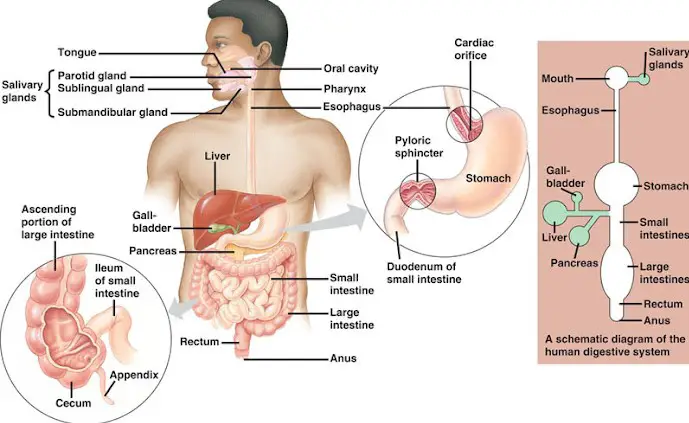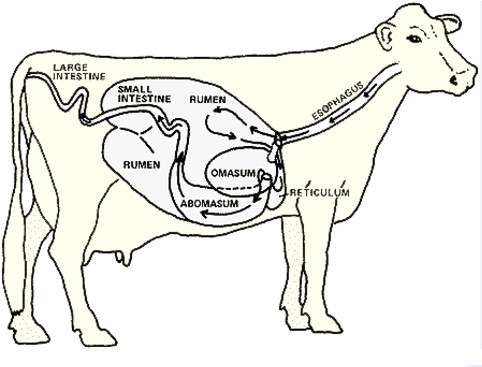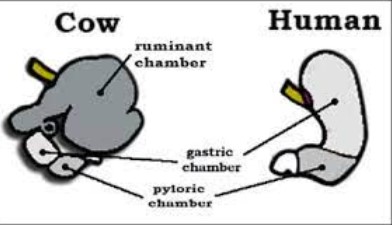Digestion is a complex process that is essential to survival. While many animals share similarities in the way they process food, there are also distinct differences in the way humans and ruminants digest their meals.
Structure of the human digestive system

The human digestive system is complex and highly efficient, allowing us to break down and absorb the nutrients we need to survive. However, there are some key differences between digestion in humans and digestion in ruminants, such as cows and sheep.
The first chamber of the ruminant stomach is called the rumen, which contains billions of microbes that break down the cellulose and convert it into energy. The second chamber is the reticulum, which is where the food is regurgitated and chewed.
The third and fourth chambers are the omasum and abomasum, where the digested food is further broken down and absorbed into the bloodstream. Humans, on the other hand, rely on enzymes and acid to break down food into molecules small enough to be absorbed. Overall, the human digestive system is less complex than that of ruminants, but is still highly effective at breaking down and absorbing the nutrients we need to stay healthy.
Overall, the human digestive system is less complex than that of ruminants, but is still highly effective at breaking down and absorbing the nutrients we need to stay healthy.
Structure of the ruminant digestive system

The digestive system of ruminants, such as cows, sheep, and goats, is very different from that of humans. Ruminants have an extra chamber in their stomachs, called the rumen, which allows them to digest tough plants that humans cannot.
The rumen is filled with bacteria and protozoa which help break down the cellulose in plants, converting it into energy for the animal. This process is known as rumination. Unlike humans, who digest their food through mechanical and chemical digestion, ruminants rely on microbial fermentation to break down their food.
In addition, ruminants can extract more energy from their food than humans can, as the bacteria and protozoa in the rumen are able to break down otherwise indigestible cellulose.
Comparison of human and ruminant digestion

Digestion is an important process in all mammals, including humans and ruminants. While both humans and ruminants have similar digestive systems, their processes differ in a few key ways. Humans have a simple stomach and small intestine that breaks down food into nutrients that can be absorbed into the bloodstream.
Ruminants, on the other hand, have a four-chambered stomach that allows them to break down and digest plant material that humans can’t. This is accomplished by the microorganisms that live in the ruminant’s stomach and break down the cellulose found in plants.
The end result is that ruminants are able to extract more nutrients from food than humans. In addition, the fermentation process that takes place in the ruminant’s stomach creates fatty acids that are beneficial to their overall health. Humans, however, cannot rely on this process for nutrition.
Ultimately, the difference between digestion in humans and ruminants is clear, and it’s important to recognize the ways in which these two species process food differently.
Role of microorganisms in ruminant digestion
Ruminants are unique amongst mammals in that their digestive system is much more complex than that of humans. The role of microorganisms in ruminant digestion is critical, as they are essential for the breakdown of tougher plant material and the production of essential nutrients.
Microbes play an important role in breaking down plant material that would otherwise be indigestible for ruminants, making them more efficient at harvesting energy from their food. Furthermore, microbes produce essential nutrients, such as amino acids and vitamins, which are necessary for the ruminant’s health. The difference between digestion in humans and ruminants is quite significant.
Humans rely on their own digestive enzymes to break down food, while ruminants rely on the help of microorganisms to do so. This additional step in the digestive process allows ruminants to extract more energy from their food than humans.
Benefits of ruminant digestion

Ruminant digestion is a complex process that is vastly different from human digestion. Ruminants, such as cows, sheep, and goats, employ a four-chambered stomach to break down the plant materials that they consume.
The four chambers work together to break down plant material, allowing the ruminant to extract more calories from the food they consume. The first chamber, the rumen, is where much of the fermentation takes place.
Microbes within the rumen digest the plant material, breaking it down into simpler compounds that are more easily absorbed. The second chamber, the reticulum, helps to filter out indigestible materials like sand and pebbles.
The third chamber, the omasum, further breaks down the plant material. Finally, the fourth chamber, the abomasum, is the true stomach and is responsible for the final digestion of the plant material. The difference between digestion in humans and ruminants is clear; ruminants are able to extract more nutrition from their food due to their complex four-chambered stomach.
This allows them to survive in environments where the plant material is sparse and nutrition is hard to come by. Ruminant digestion is a truly remarkable process, and it is clear why it has been so important in the evolution of these amazing animals.
Final Touch
In conclusion, there are many differences between the digestion process in humans and ruminants. Humans rely on their stomach and small intestine to break down food into nutrients that can be absorbed and used by the body. Ruminants, on the other hand, have evolved a more complex four-chambered stomach that is capable of breaking down plant material with the help of bacteria and protozoa.
This allows them to digest a wider variety of food than humans. Additionally, humans use enzymes and acids to break down food, while ruminants rely on bacteria to produce the enzymes necessary for digestion.
Ultimately, these differences are what allow humans and ruminants to survive on different diets.
